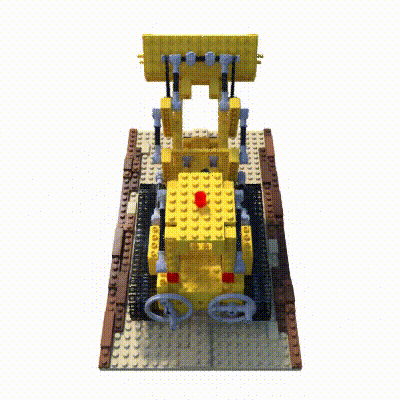A neural radiance field (NeRF) is a fully-connected neural network that can generate novel views of complex 3D scenes, based on a partial set of 2D images. It is trained to use a rendering loss to reproduce input views of a scene. It works by taking input images representing a scene and interpolating between them to render one complete scene. NeRF is a highly effective way to generate images for synthetic data.
A NeRF network is trained to map directly from viewing direction and spatial location (5D input) to opacity and color (4D output), using volume rendering to render new views. NeRF is a computationally-intensive algorithm, and processing of complex scenes can take hours or days. However, new algorithms are available that dramatically improve performance.
Play with NeRF in ipynb in Colab: nerf.ipynb.
pip install tqdm==4.64.0 configargparse==1.5.3 imageio==2.19.3 opencv-python==4.6.0.66Download link: nerf_ckpts.zip.
Lego:
- Coarse: 192 pts/ray
- Coarse: 64 pts/ray + Fine: 128 pts/ray
Fern:
- Coarse: 192 pts/ray
- Coarse: 64 pts/ray + Fine: 128 pts/ray
| Lego | Speed | PSNR ↑ | SSIM ↑ | LPIPS ↓ |
|---|---|---|---|---|
| Coarse: 192 pts/ray (torch converted ckpt) | 13.37s/img | 30.52 | 0.9565 | 0.032 |
| Coarse: 192 pts/ray (Train from scratch) | 13.37s/img | 28.16 | 0.9233 | 0.055 |
| Coarse: 64 pts/ray + Fine: 128 pts/ray (torch converted ckpt) | 1305.28s/img | N/A | N/A | N/A |
| Coarse: 64 pts/ray + Fine: 128 pts/ray (Train from scratch) | 1305.28s/img | N/A | N/A | N/A |
| Paper: 64 pts/ray + Fine: 128 pts/ray | 4.69s/img | 32.54 | 0.961 | 0.050 |
| Fern | Speed | PSNR ↑ | SSIM ↑ | LPIPS ↓ |
|---|---|---|---|---|
| Coarse: 192 pts/ray (torch converted ckpt) | 13.37s/img | 26.06 | 0.8305 | 0.095 |
| Coarse: 192 pts/ray (Train from scratch) | 13.37s/img | 25.43 | 0.7963 | 0.121 |
| Coarse: 64 pts/ray + Fine: 128 pts/ray (torch converted ckpt) | 1305.28s/img | N/A | N/A | N/A |
| Coarse: 64 pts/ray + Fine: 128 pts/ray (Train from scratch) | 1305.28s/img | N/A | N/A | N/A |
| Paper: 64 pts/ray + Fine: 128 pts/ray | 4.69s/img | 25.17 | 0.792 | 0.280 |
the significant speed drop comes from the unsupported N-dim ms.numpy.searchsorted that instead implemented with a for loop. Related issue.
Please check out the config script and the config file.
Here, how to use NeRF model will be introduced as following.
Download link: nerf_mindspore_data.zip.
At first, you should download dataset by yourself. NeRF Synthetics.
After you get the dataset, make sure your path is sturctured as following:
.datasets/
└── nerf_synthetics
└── lego
├── test [600 entries exceeds filelimit, not opening dir]
├── train [100 entries exceeds filelimit, not opening dir]
├── transforms_test.json
├── transforms_train.json
├── transforms_val.json
└── val [100 entries exceeds filelimit, not opening dir]
and modify the datadir in the config file accordingly.
python {train,eval,infer}.py --config ./configs/lego.txt \
[--ckpt /path/to/checkpoint] [--no_reload] [--gpu 0] \
[--render_test]
# `--no_reload`: not resume from last run.
# `--gpu`: the used gpu.
# `--ckpt`: specify the path of a checkpoint (from trained or downloaded).
# `--render_test`: render test images to perform quantitative comparison.Script download link: metric_psnr_ssmi_lpips.py.py
